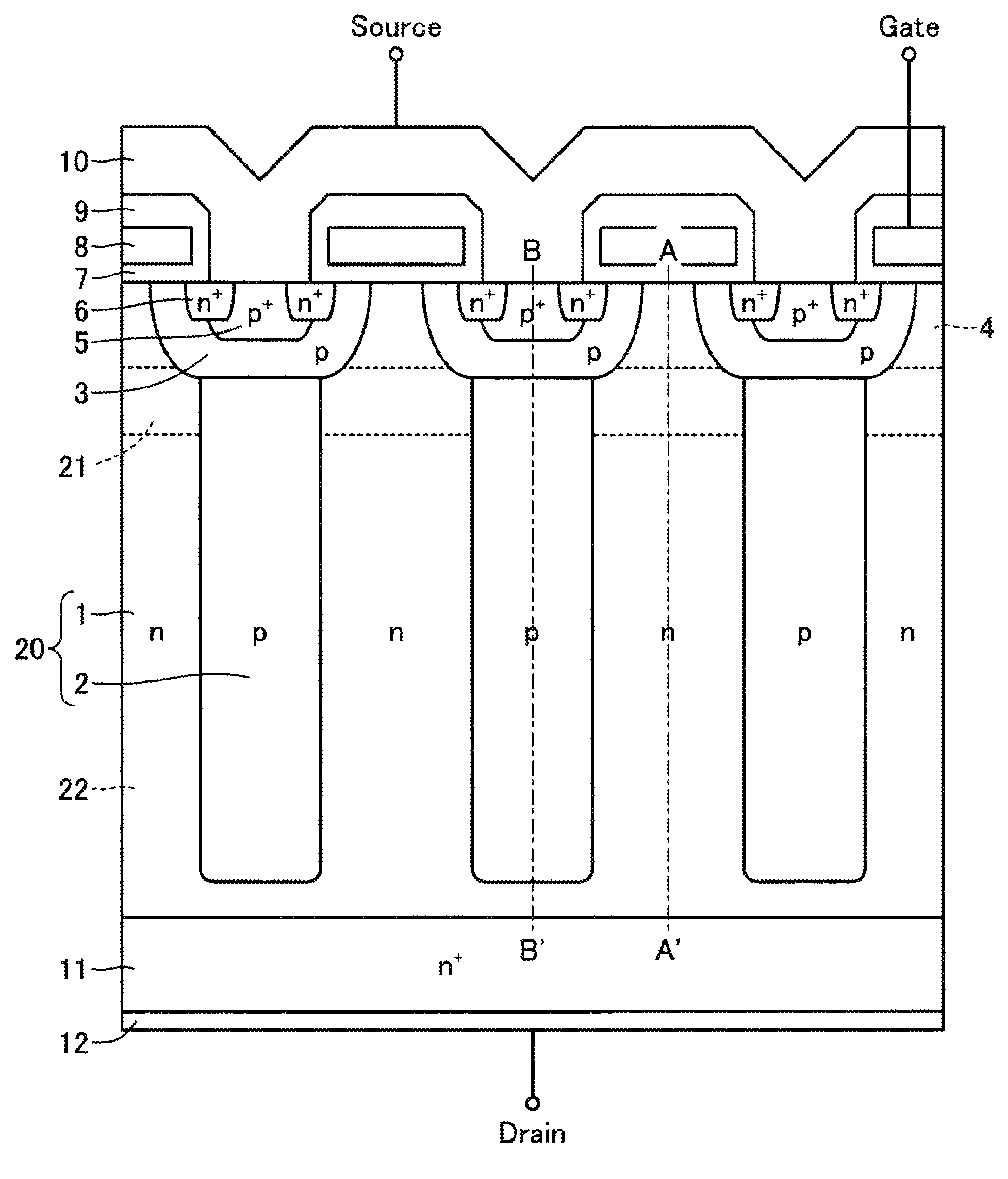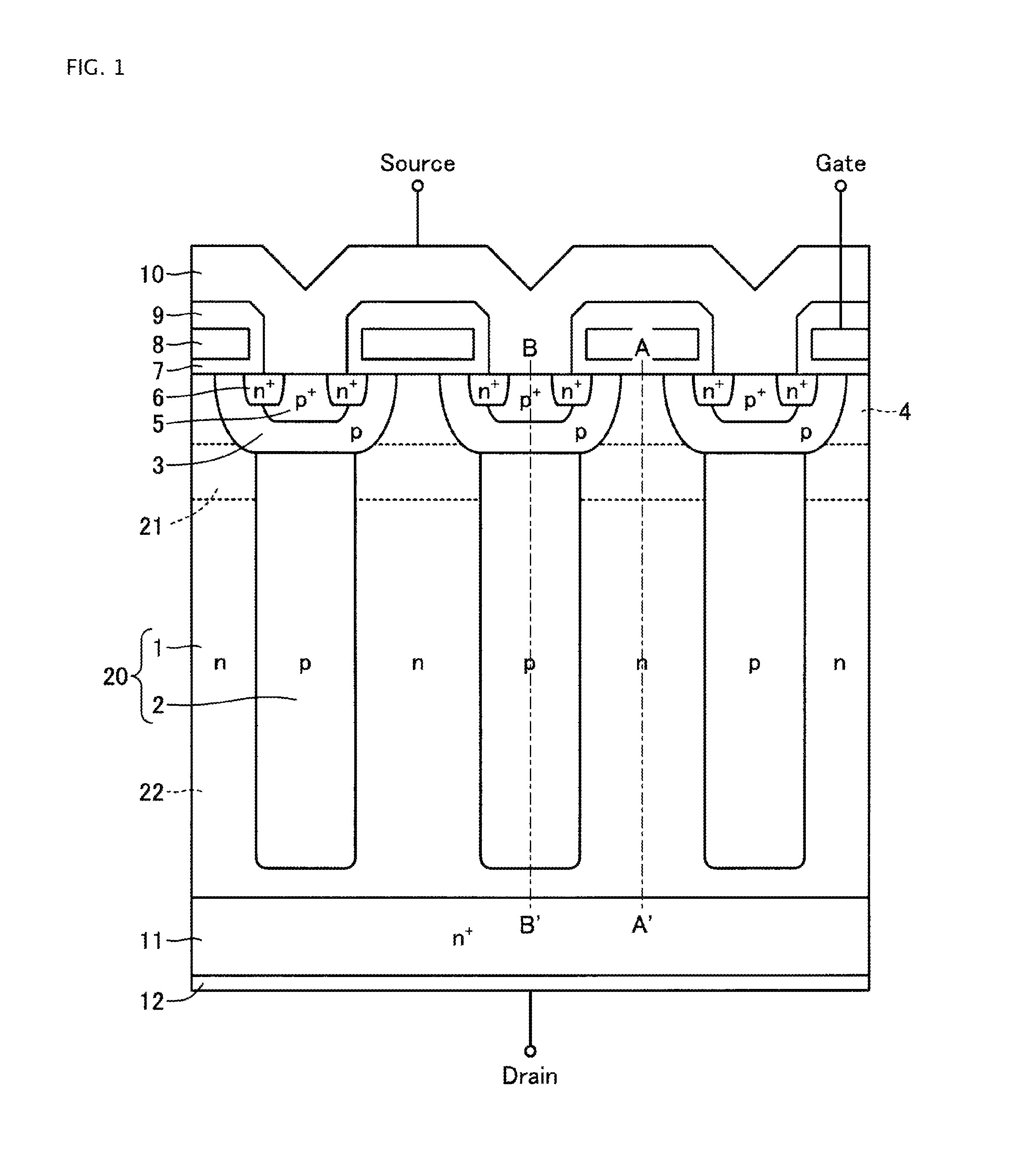Superjunction semiconductor device with reduced switching loss
- Summary
- Abstract
- Description
- Claims
- Application Information
AI Technical Summary
Benefits of technology
Problems solved by technology
Method used
Image
Examples
embodiment 1
[0091]FIG. 1 is a sectional view showing a semiconductor device according to Embodiment 1. The semiconductor device, shown in FIG. 1 has an active portion on a first main surface side, and has an n+ drain region (a low resistance layer) 11 on a second main surface side. A p-base region (a second conductivity type base region) 3, an n-type surface region (a first conductivity type surface region) 4, a p+ contact region 5, an n+ source region 6, a gate insulating film 7, a gate electrode 8, an interlayer insulating film 9, and a source electrode 10 are provided as, for example, a planar type MOSFET surface structure in the active portion. A drain electrode 12 in contact with the n+ drain region 11 is provided on the second main surface.
[0092]A parallel p-n layer 20 is provided as a drift layer between the active portion and the n+ drain region 11. The parallel p-n layer 20 is formed by an n-type region (a first conductivity type region) 1 and a p-type region (a second conductivity typ...
embodiment 2
[0103]FIG. 3 is a sectional view showing a semiconductor device according to Embodiment 2. A trench structure may also be applied in Embodiment 1.
[0104]In Embodiment 2, a trench structure, wherein a gate electrode 18 is provided across a gate insulating film 17 inside a trench, is configured on the upper end side of the n-type region 1. The p-base region 3 and source region 6 are in contact with the gate insulating film 17 provided on a trench side wall. The source electrode 10 is isolated from the gate electrode 18 by an interlayer insulating film 19. No n-type surface region is provided.
[0105]An n-type impurity concentration distribution of the n-type region 1 along the cut line of C-C′ in FIG. 3 is the same as the n-type impurity concentration distribution of the n-type region 1 along the cut line of A-A′ in Embodiment 1 (refer to FIG. 1 and FIG. 2). As no n-type surface region is provided in the semiconductor device shown in FIG. 3, the n-type impurity concentration distribution...
embodiment 3
[0107]FIG. 4 is a sectional view showing a semiconductor device according to Embodiment 3. In FIG. 4, only one p-n junction of the parallel p-n layer 20 is shown (hereafter, the same also applies in FIG. 6 and FIG. 8). In Embodiment 1, the impurity concentration of the first main surface side of the p-type region 2 may be higher than the impurity concentration of the second main surface side of the p-type region 2.
[0108]In Embodiment 3, a p-type high concentration region (a second conductivity type high concentration region) 23 is provided on the first main surface side of the p-type region 2. The p-type high concentration region 23 is in contact with the lower end of the p-base region 3. Also, the p-type high concentration region 23 has a higher impurity concentration than a region (hereafter referred to as a p-type low concentration region) 24 of the p-type region 2 excepting the p-type high concentration region 23.
[0109]Also, the p-type high concentration region 23 has the same t...
PUM
 Login to View More
Login to View More Abstract
Description
Claims
Application Information
 Login to View More
Login to View More - R&D
- Intellectual Property
- Life Sciences
- Materials
- Tech Scout
- Unparalleled Data Quality
- Higher Quality Content
- 60% Fewer Hallucinations
Browse by: Latest US Patents, China's latest patents, Technical Efficacy Thesaurus, Application Domain, Technology Topic, Popular Technical Reports.
© 2025 PatSnap. All rights reserved.Legal|Privacy policy|Modern Slavery Act Transparency Statement|Sitemap|About US| Contact US: help@patsnap.com



